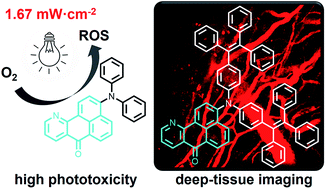Red-emissive azabenzanthrone derivatives for photodynamic therapy irradiated with ultralow light power density and two-photon imaging†
Abstract
Photodynamic therapy has proved to be an effective strategy for cancer therapy, and advanced photosensitizers for image-guided photodynamic therapy require biocompatibility, intense absorption, high ROS generation efficiency, phototoxicity, low irradiation power density and efficient emission. In this work, four red emissive azabenzanthrone derivatives have been designed and synthesized, which generally exhibit efficient aggregated state emission. Through structural optimization, 3-diphenylamino-11-azabenzanthrone was found to show satisfactory photo-induced ROS generation and high emission efficiency in the aggregated state. Under the irradiation of a white LED lamp with an ultralow power density of 1.67 mW cm−2, this compound demonstrates significant photo-induced cytotoxicity toward HeLa cells. Moreover, deep tissue penetration can be realized by two-photon imaging of mouse brain vessels with these azabenzanthrone derivatives at vertical depths of up to 280 μm, attributed to the large emission wavelength and efficient emission.



 Please wait while we load your content...
Please wait while we load your content...